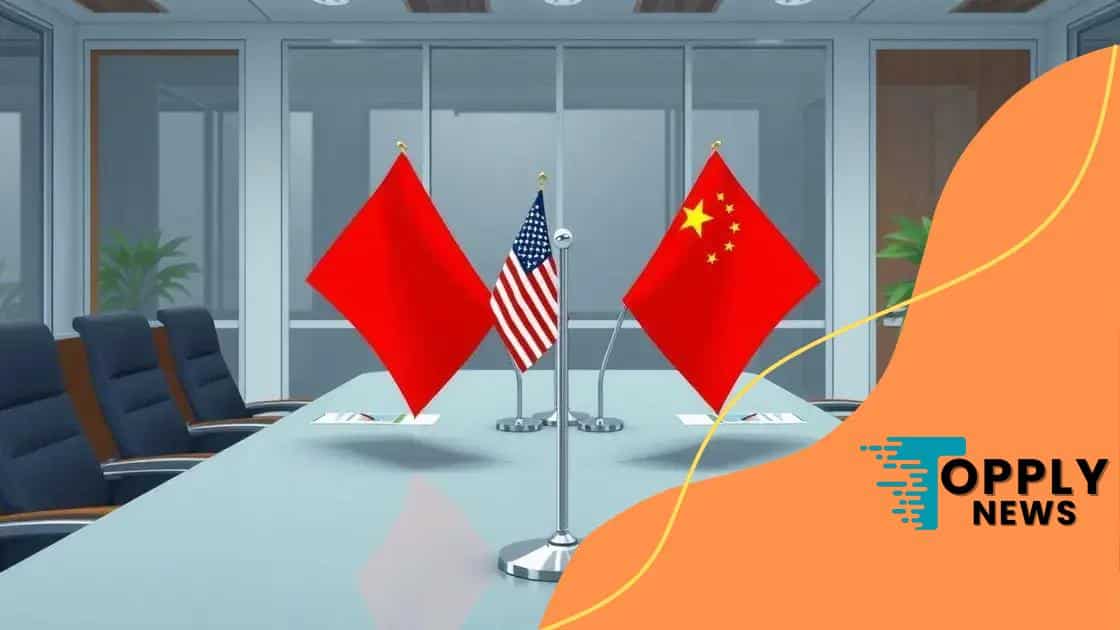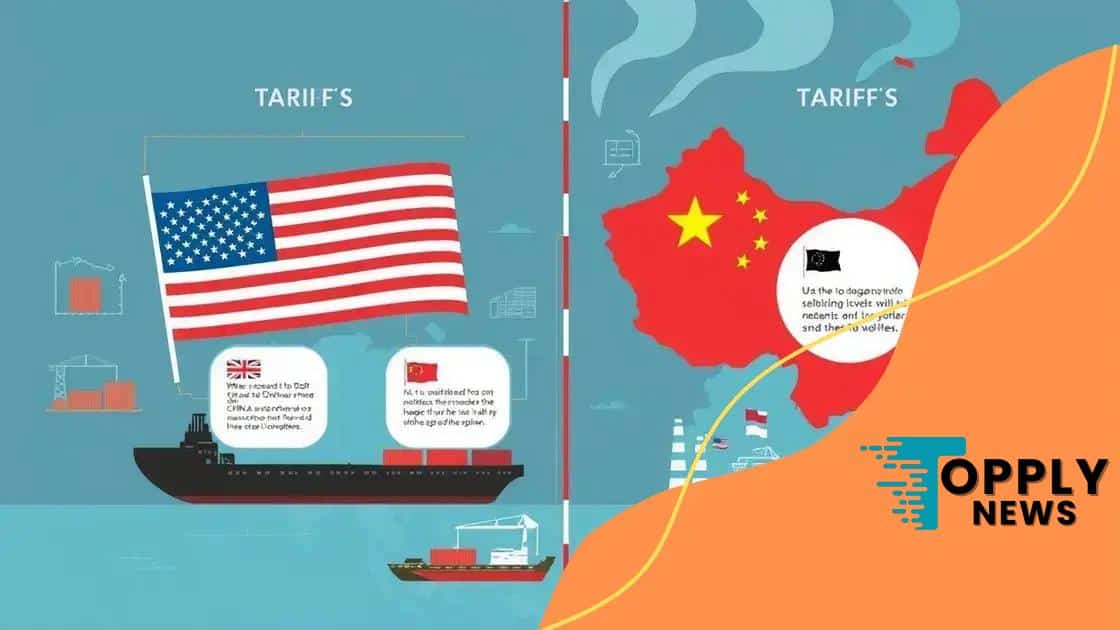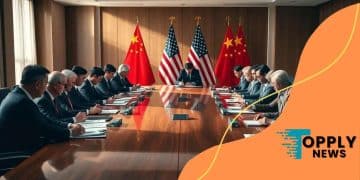US-China trade talks May 2025: what to expect

The US-China trade talks in May 2025 are crucial for determining future economic relations, focusing on issues like tariffs, technology, and intellectual property to foster cooperation and address ongoing challenges.
US-China trade talks May 2025 are poised to influence not just the two nations but the entire global economy. With key issues at stake, how will these discussions shape our economic landscape? Let’s dive into the details.
An overview of US-China trade relations
The relationship between the US and China has evolved significantly over the years, affecting global trade dynamics. Understanding the US-China trade relations is crucial, as they play a vital role in economic stability worldwide. This overview will explore the foundations and current state of this important partnership.
The Beginning of Trade Relations
The US and China began trade relations in the late 20th century. Initially, this partnership was fueled by mutual benefits. As China opened its markets, the US found a vast audience for its goods. This early cooperation laid the groundwork for the complex relationship that exists today.
Key Events Shaping Relations
Several key events have shaped the trajectory of US-China trade relations:
- The WTO accession in 2001 allowed China to participate more fully in global trade.
- The 2018 trade war introduced tariffs that impacted both economies.
- Recent negotiations have focused on resolving issues such as intellectual property and market access.
These events reveal the evolving nature of trade policies and agreements between the two countries. Beyond tariffs, issues like technology transfer and trade balances are frequently at the forefront of discussions. Navigating these challenges requires careful diplomacy.
The Current Trade Landscape
Today, US-China trade relations are characterized by tension but also opportunities. While tariffs still exist, both nations recognize the importance of economic collaboration. Many sectors benefit from these exchanges, including technology, agriculture, and manufacturing.
As we move closer to the May 2025 talks, understanding the past will help predict future developments. Recent trends suggest that both nations are exploring ways to reduce tensions, focusing on mutual benefits. Moving forward requires strategic planning to address existing conflicts while fostering cooperation.
This complex relationship highlights the delicate balance between competition and partnership. By acknowledging their interdependence, both countries can work towards a more stable economic future.
Key topics on the agenda for May 2025
As the US-China trade talks in May 2025 approach, several key topics will dominate the agenda. These discussions play a significant role in shaping the future of international trade and cooperation.
Intellectual Property Rights
One of the most pressing issues is intellectual property rights. Both countries have concerns regarding the protection of their innovations. The US has repeatedly accused China of stealing technology and intellectual property. Resolving this issue is crucial for fostering trust and collaboration.
Tariffs and Trade Barriers
Another important topic is the existing tariffs and trade barriers. High tariffs imposed during the trade war have affected various industries. Negotiations will focus on ways to reduce or eliminate these barriers, which could lead to a more balanced trade relationship.
- Possibilities for tariff reductions on select goods.
- Potential reforms to address trade imbalances.
- Negotiations regarding agricultural trade access and quotas.
Addressing tariffs is vital for revitalizing trade flows between the two nations. By finding a compromise, both countries can benefit from a more efficient trade environment.
Technology and Cybersecurity
Technology is another critical issue on the agenda. As both nations advance, cybersecurity challenges arise. Protecting sensitive information and infrastructure is essential. The discussions will likely include agreements on technology sharing while also ensuring security measures are in place.
Moreover, the rise of tech giants in both countries has transformed the global landscape. Balancing competition and cooperation in technology is necessary for mutual growth. As these talks progress, it will be essential to find common ground to harness the benefits of innovation.
Trade talks are also likely to address environmental regulations. With growing concerns about climate change, both nations must consider how trade policies can align with sustainability goals. This collaboration can lead to innovative solutions that benefit both the economy and the planet.
Impact of tariffs on both economies

The impact of tariffs on both the US and Chinese economies is significant and multifaceted. Tariffs can alter trade patterns, affect prices, and influence consumer choices. As both nations navigate their economic relationships, understanding these effects becomes essential.
Price Changes and Inflation
When tariffs are imposed, the cost of imported goods often rises. This increase can lead to higher prices for consumers. In the US, many products rely on components sourced from China. When tariffs increase, manufacturers may pass these costs onto consumers.
Effects on Domestic Industries
Tariffs can protect certain US industries by making foreign goods more expensive. This protection might benefit sectors like steel and agriculture. However, it can also harm industries reliant on imported materials. For instance, manufacturers who depend on Chinese parts may face escalating costs.
- Increased costs for production can reduce profit margins.
- Job losses may occur in industries struggling to compete.
- Export-oriented businesses could suffer from retaliatory tariffs.
Conversely, Chinese industries also feel the impact. As tariffs limit access to the US market, some companies may struggle to maintain their profit levels. This situation could lead to job cuts and reduced investments in innovation.
Trade Balances and Economic Growth
Tariffs affect overall trade balances. An increase in US tariffs on Chinese products might lead to a trade deficit reduction in the short term. However, long-term effects can complicate matters. When consumer purchasing power drops due to higher prices, it can lead to slower economic growth.
In summary, while tariffs are intended to protect specific domestic industries, they can create unexpected consequences. Both economies must consider these impacts when negotiating future trade agreements. As the May 2025 talks approach, the relationship between tariffs and economic health remains a central focus.
The role of technology in trade discussions
The role of technology in trade discussions is increasingly important in today’s global economy. As nations navigate complex trade relationships, technology acts as both a facilitator and a challenge. It impacts everything from communication to the exchange of goods.
Advancements in Communication
Technology has revolutionized how countries communicate during trade talks. Instant communication tools allow for real-time discussions, making negotiations more efficient. Through video conferencing and secure messaging, representatives can address concerns swiftly, ensuring no time is wasted.
Digital Trade Agreements
Another major aspect is the inclusion of digital trade agreements in negotiations. These agreements focus on data flow, cybersecurity, and the protection of intellectual property online. As digital commerce grows, these topics are essential to define the future of trade.
- Provisions for cross-border data transfer.
- Regulations on e-commerce transactions.
- Agreements on protecting online consumers.
Establishing clear guidelines for digital trade can enhance cooperation between nations and minimize disputes. Both the US and China recognize that a robust digital economy relies on strong agreements.
Impact on Manufacturing and Distribution
Furthermore, technology affects manufacturing and distribution processes. Automated systems and artificial intelligence improve efficiency and reduce costs. With supply chains becoming more automated, discussions about technological standards are vital.
Innovation in logistics allows for faster delivery and improved inventory management. As countries integrate these technologies into their economies, they must discuss how to harmonize practices to facilitate smoother trade.
In summary, technology is a double-edged sword in trade discussions. While it offers opportunities for growth and efficiency, it also presents challenges that need careful negotiation. As the May 2025 talks approach, how both nations utilize technology will significantly influence their trade relationship.
Future outlook for US-China relations
The future outlook for US-China relations is complex and critical for global economics. As both nations navigate their interests, various factors will influence how their relationship evolves over time.
Economic Cooperation and Competition
One of the primary dynamics will be balancing cooperation and competition. As the world’s largest economies, the US and China have much to gain from collaborating on global issues, such as climate change and public health. However, they also face intense competition in technology and trade.
Potential for Trade Agreements
Future trade agreements will play a key role in shaping relations. Negotiations will likely focus on reducing tariffs and addressing trade imbalances. A successful agreement could lead to a more stable trading environment.
- Possibilities for easing tariffs on essential goods.
- Commitments to protect intellectual property.
- Increased market access for both countries.
These elements are crucial for fostering economic ties and building trust between the nations. If both sides can compromise, the prospects for improved relations look promising.
Geopolitical Factors
Geopolitical issues will also influence the future of US-China relations. Regional conflicts, alliances, and military presence can complicate interactions. For instance, tensions in areas like the South China Sea may affect diplomatic efforts.
As both nations strive to maintain their global influence, their approaches to international partnerships will matter greatly. Understanding these geopolitical nuances is key to comprehending their future interactions.
The rising importance of technology poses both opportunities and challenges. Technological advancements can drive economic growth, but they also require careful management of cybersecurity and data privacy. How both nations approach these issues will shape their relationship moving forward.
FAQ – Frequently Asked Questions about US-China Trade Relations
What are the main challenges in US-China trade relations?
The main challenges include tariffs, intellectual property concerns, and geopolitical tensions that impact negotiations.
How do tariffs affect consumers in the US?
Tariffs can lead to higher prices for imported goods, increasing costs for consumers and affecting their purchasing power.
What role does technology play in trade discussions?
Technology facilitates communication and can impact trade agreements, especially in areas like e-commerce and cybersecurity.
What could improve the future of US-China relations?
Improved cooperation on trade agreements, addressing cybersecurity concerns, and finding common ground on global issues could enhance relations.





